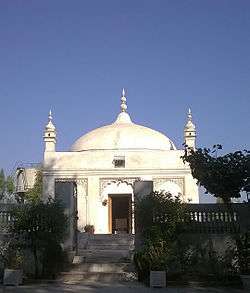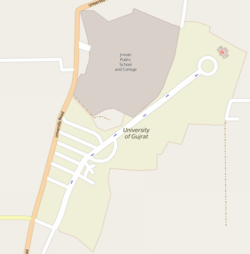Hafiz Hayat
Hafiz Hayat (Urdu: حافظ حیات) is a place in district of Gujrat, Pakistan. It is named after a local Sufi saint Hafiz Muhammad Hayat.
Hafiz Hayat حافظ حیات | |
|---|---|
 Shrine of Hafiz Muhammad Hayat | |
 Map of Hafiz Hayat | |
| Country | |
| Province | Punjab |
| District | Gujrat |
| Time zone | UTC+5 (PST) |
| Calling code | 053 |
History
Hafiz Muhammad Hayat travelled from Delhi to Wazirabad during the Mughal period. He was advised by a saint, Baqi Shah, to settle across the Chenab River near the fort of Raja Kaladhv. The fort was surrounded by a dense forest and it was later settled by Hafiz Hayat when he aided people with his spiritual aura. Though the exact dates are unknown but according to one tradition it was at the time of Emperor Jahangir when the saint contributed his entire land holding to the then state for the cause of education.[1] The main campus of University of Gujrat has been constructed on the land donated by Hafiz Muhammad Hayat and is named after him.[2][3]
Shrine of Hafiz Hayat
The shrine of Hafiz Hayat rests on a mound six feet high above the plain. The site consists of a haveli, baradari, mosque, four tombs of different proportions, some graves, seven waterholes and old trees. The place was initially the property of the then ruler Raja Kaladhvi.[3]
References
- "Archived copy". Archived from the original on 27 April 2015. Retrieved 20 April 2015.CS1 maint: archived copy as title (link)
- "History - University of Gujrat". uog.edu.pk. Archived from the original on 13 June 2017. Retrieved 22 February 2018.
In 2003, the Punjab government, led by then-Chief Minister Chaudhry Pervez Elahi, established UOG on the vacant land adjoining the shrine of saint Hafiz Muhamad Hayat, who lived in the Mughal period.
- Legend of Hafiz Hayat Archived 2012-03-04 at the Wayback Machine, Jan 2005